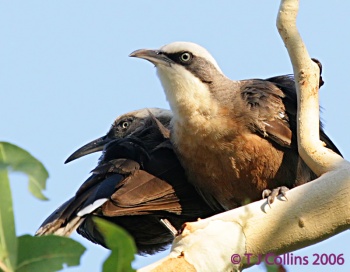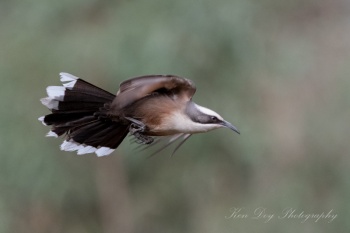Alternative names: Grey-crowned Chatterer; Red-breasted Babbler; Rufous-breasted Babbler (rubeculus)
- Pomatostomus temporalis
Identification
23 - 27cm (9-10¾ in). The largest Australasian Babbler:
- Narrow grey crown bordered by broad white eyebrow
- Dark brown eye stripe
- Black, long and down-curved bill
- Pale yellow eye
- Greyish-brown upperparts, darker rump
- Blackish-brown long tail with broad white tip
- White throat and upper breast merging to grey breast
- Rufous-brown belly
Sexes similar. Juveniles similar to adults but with shorter and less curved bill and dark brown eye.
Variations
- Rubeculus has a rufous breast
Distribution
Southern New Guinea and northwest, north, central and east Australia.
Locally common.
Taxonomy
Subspecies
Three subspecies accepted[1]:
- P. t. strepitans:
- South New Guinea (Orimo River to Digul River)
- P. t. temporalis:
- East Australia (Cape York Peninsula to cape Victoria and south-eastern South Australia)
- P. t. rubeculus:
- North Australia (Shark Bay, Western Australia to north-western Queensland)
They are sometimes split into two species. Furthermore due to the clinal variation much more subspecies are described but usually not accepted.
Habitat
Dry open forest, scrubby woodlands, farmland with isolated trees and trees bordering roads.
Behaviour
They go around in family groups seeking out bugs to feed on, all the while making many curious calls, some that sound like kittens mewing or squeaky toys. Their method of locomotion is a comical bounce. At night they roost in communal nests but if some family members don't fit in the main nest they are turfed out and must use a nearby "guest" nest.
Diet
Feeds mainly on insects but takes also seeds, spiders, scorpions or small reptiles.
Breeding
Breeding season mainly July to February but recorded in all months. Co-operative breeder. Lays 2 - 6 eggs.
Movements
Mainly resident but some evidence for nomadism.
Vocalisation
Call: a ruff-ruff call, rather like a puppy.
References
- Clements, J. F., T. S. Schulenberg, M. J. Iliff, S. M. Billerman, T. A. Fredericks, B. L. Sullivan, and C. L. Wood. 2019. The eBird/Clements Checklist of Birds of the World: v2019. Downloaded from http://www.birds.cornell.edu/clementschecklist/download/
- Del Hoyo, J, A Elliott, and D Christie, eds. 2007. Handbook of the Birds of the World. Volume 12: Picathartes to Tits and Chickadees. Barcelona: Lynx Edicions. ISBN 978-8496553422
- Simpson, K and N Day. 1998. Field Guide to the Birds of Australia. London: Christopher Helm. ISBN 0-7136-4877-5
- BirdForum Member observations
Recommended Citation
- BirdForum Opus contributors. (2024) Grey-crowned Babbler. In: BirdForum, the forum for wild birds and birding. Retrieved 27 April 2024 from https://www.birdforum.net/opus/Grey-crowned_Babbler
External Links
Search the Gallery using the scientific name:
Search the Gallery using the co9mmon name:
GSearch checked for 2020 platform.







